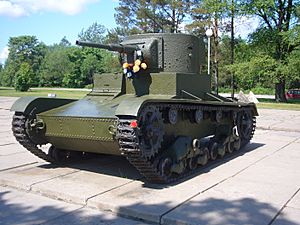T-26 facts for kids
Quick facts for kids T-26 |
|
|---|---|

T-26 mod. 1933 at the museum "Breaching of the Leningrad Blockade" near Kirovsk, Leningrad Oblast. This tank was raised from a river bottom at Nevsky Pyatachok in May 2003.
|
|
| Type | Light infantry tank |
| Place of origin | |
| Service history | |
| In service | 1931–1945 in USSR 1936–1953 in Spain 1940–1961 in Finland |
| Wars | Spanish Civil War Second Sino-Japanese War Soviet–Japanese Border Wars World War II
|
| Production history | |
| Designer | Vickers-Armstrongs, OKMO of Bolshevik Plant in Leningrad |
| Designed | 1928–1931 |
| Manufacturer | Factory No. 174 named after K.E. Voroshilov in Leningrad, Stalingrad Tractor Factory |
| Produced | 1931–41 |
| No. built | 10,300 tanks and 1,701 other vehicles |
| Specifications (T-26 mod. 1933) | |
| Mass | 9.6 tonnes (10.6 short tons) |
| Length | 4.65 m (15 ft 3 in) |
| Width | 2.44 m (8 ft) |
| Height | 2.24 m (7 ft 4 in) |
| Crew | 3 (commander, gunner, driver) |
|
|
|
| Armour | Bottom: 6 mm (0.24 in) Roof: 6–10 mm (0.24–0.39 in) Hull and Turret: 15 mm (0.59 in) (front, rear, sides) |
|
Main
armament |
45 mm 20K mod. 1932/34 tank gun (122 rds.) |
|
Secondary
armament |
7.62 mm DT tank machine gun (2,961 rds.) |
| Engine | 4-cylinder gasoline flat air-cooled T-26 (Armstrong Siddeley type); engine volume 6,600 cc 90 hp (67 kW) at 2,100 rpm |
| Power/weight | 9.38 hp/t |
| Transmission | single-disk main dry clutch, drive shaft, gearbox with five gears, steering clutches, final drives |
| Suspension | leaf quarter-elliptic springs |
| Ground clearance | 380 mm (1 ft 3 in) |
| Fuel capacity | 290 L (64 imp gal; 77 U.S. gal) [with additional 110-L fuel tank] |
|
Operational
range |
Road: 220–240 km (140–150 mi) Off-road: 130–140 km (81–87 mi) |
| Maximum speed | Paved: 31.1 km/h (19.3 mph) Gravel: 22 km/h (14 mph) Off-road: 16 km/h (9.9 mph) |
The T-26 was a light tank used by the Red Army (the Soviet Union's army) in the 1930s and during World War II. It was an improved version of a British tank called the Vickers 6-Ton. The T-26 was considered one of the best tank designs from the 1920s. However, it started to have problems when new anti-tank guns were invented. These new guns could easily shoot through the T-26's thin armor.
Contents
Building the T-26 Tank
More T-26 tanks were made than any other tank of that time. Over 11,000 of them were built. During the 1930s, the Soviet Union created 53 different types of T-26 tanks. This shows how important it was to their army.
The T-26 and the BT tank were the main tanks used by the Red Army in the 1930s.
Where the T-26 Fought
Even though the T-26 was not strong enough for battles at the start of World War II, it played a very important role in the Spanish Civil War. It was also used in the Battle of Lake Khasan in 1938 and the Winter War in 1939–40.
When Germany invaded the Soviet Union in June 1941 (an event called Operation Barbarossa), the Red Army mostly had T-26 tanks. These tanks were used against the Germans in big battles like the Battle of Moscow (1941–1942), the Battle of Stalingrad, and the Battle of the Caucasus (both in 1942–1943). Some T-26 units from the Leningrad Front continued to use their tanks until 1944. The last time Soviet T-26 light tanks were used was in August 1945. This was during the defeat of the Japanese army in Manchuria.
Who Else Used the T-26?
The T-26 was sold to other countries like Spain, China, and Turkey. Also, armies from Finland, Germany, Romania, and Hungary used T-26 tanks they had captured during battles.
Design and Improvements
The T-26 was known for being reliable and easy to fix. Its design was improved between 1931 and 1941. However, no new models of the T-26 were made after 1940.
Images for kids
-
A T-26 operated by Republican forces during the Battle of Belchite in 1937.
-
A column of T-26 mod. 1939 and T-26 mod. 1933 light tanks from the 20th Tank Brigade move towards a front line. The Western Front, Battle of Moscow. December 1941.
-
Twin-turreted T-26 mod. 1931 with riveted hull and turrets, armed with the 37 mm Hotchkiss gun (PS-1) in the right turret. Battle of Tolvajärvi. December 1939.
-
Twin-turreted T-26 armed with the 76.2 mm recoilless gun designed by L.V. Kurchevsky in the right turret. 1934.
-
Twin-turreted T-26 (with the 37 mm Hotchkiss gun (PS-1) in the right turret), equipped with the radio station No. 7N and the hand-rail frame antenna on the hull. Military exercises. 1934.
See also
 In Spanish: T-26 para niños
In Spanish: T-26 para niños















